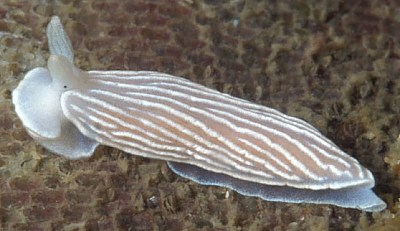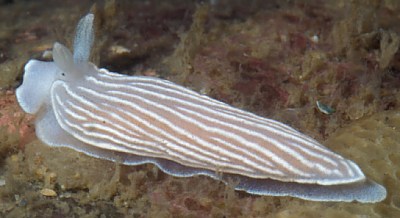

Dermatobranchus sp. 8
Order: NUDIBRANCHIA
Suborder: ARMININA
Family: Arminidae
DISTRIBUTION
Apparently endemic to temperare South Africa.
PHOTO
off Port Elizabeth, Eastern Cape, South Africa, 23 February 2002, depth 13m. Water temp: 15-16C. Length: 11mm. Photos: Lindsay Warren
Terry Gosliner (1987) lists this as Dermatobranchus sp. 1. He considers it to be quite common, reporting numerous specimens being found at Oudekraal along the Atlantic coast of the Cape Peninsula, and at Port Elizabeth. He notes that it feeds on the soft coral Sarcophyton trochiforme in 10-15m.
Reference:
• Gosliner, T., 1987. Nudibranchs of Southern Africa.
Rudman, W.B., 2002 (October 21) Dermatobranchus sp. 8 [In] Sea Slug Forum. Australian Museum, Sydney. Available from http://www.seaslugforum.net/find/dermsp8
Related messages
Juvenile shape compared to an adult's
February 27, 2004
From: Sakkie du Preez
Hi Bill
I have a question regarding juvenile nudibranch and their body shapes, compared to their adult counterparts. I found a message [#7975] on the Forum about a very small Dermatobranchus found by Lindsay Warren in our region (Port Elizabeth, South Africa).
Being a tiny slug, I can understand if I haven't seen it before, although we frequently go out to search for macro nudi photo opportunities! And according to Terry Gosliner [see Fact Sheet] it is supposed to be quite common!?
Now, to come back to my original question, is it possible that this nudi changes shape radically when it becomes bigger or does nudi's generally keep their body shape? For example, could this nudi turn out to be the Leminda millecra when bigger? Although I recall seeing quite small L. milecra before…
Thanks & regards
Sakkie
sakkie.dupreez@comau.co.za
du Preez, S., 2004 (Feb 27) Juvenile shape compared to an adult's. [Message in] Sea Slug Forum. Australian Museum, Sydney. Available from http://www.seaslugforum.net/find/12321Dear Sakkie,
Juvenile slugs certainly chnage shape as they grow but the change usually involves growing into their real shape from a rather shapeless tiny slug. For example, juvenile aeolids start out without cerata and in most nudibranchs the rhinophores don't develop their characteristic shapes for a few weeks.
To your question about Dermatobranchus turning into Leminda. The photos of Dermatobranchus sp. 8 on the Forum are of an animal with its full adult shape. There are many species of Dermatobranchus which don't get much bigger than 5mm, when fully adult so I am pretty sure this one doesn't have much growing to do.
Why haven't you seen it? I am afraid that is one of the frustrations of nudibranch research. One year a species will be very common, and then you won't see it again for 2 or 3 years. I guess when species have planktonic larvae and very specialised food requirements, the chances of a 'swarm' of larvae finding their required food colony at any one spot is quite small. Terry Gosliner mentions the name of the soft coral Sarcophyton trochiforme as the food choice of Dermatobranchus sp. 8. I suspect your best bet is to identify that soft coral and look for the nudibranch on the colony. It may turn out to be more common than you think.
Good Luck
Bill Rudman
Dermatobranchus from Eastern Cape, South Africa
October 23, 2002
From: Lindsay Warren


Dear Bill,
Please find attached photos of what Terry Gosliner lists as Dermatobranchus sp. 1 in his 1987 book. I found this will diving off Port Elizabeth, Eastern Cape, South Africa on 23 February 2002 at a depth of 13m. Water temp: 15-16C. L: 11mm. The specimen (LCRW0002) has been preserved and is in the process of being registered at the Natural History Museum, London should someone need it for descriptive purposes.
All the best
Lindsay
alldcl@compuserve.com
Warren, L., 2002 (Oct 23) Dermatobranchus from Eastern Cape, South Africa. [Message in] Sea Slug Forum. Australian Museum, Sydney. Available from http://www.seaslugforum.net/find/7975Thanks Lindsay,
It is quite a distinctive species, and probably endemic to southern Africa so I will keep it on a separate page as Dermatobranchus sp. 8.
Best wishes,
Bill Rudman
